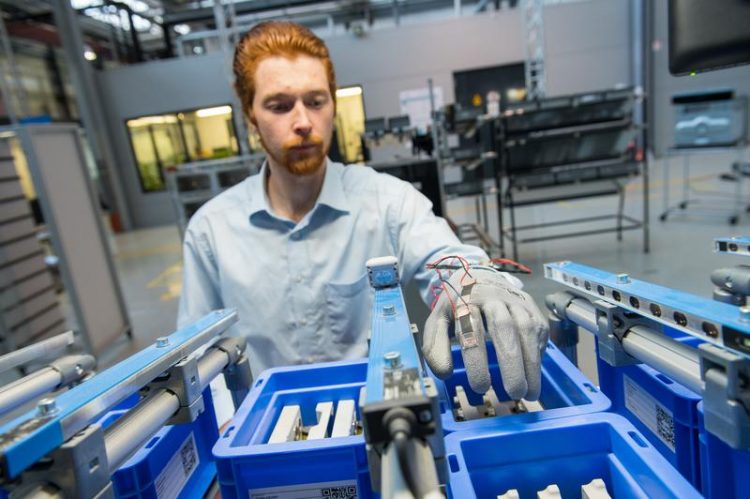Smart glove for Industry 4.0: Connecting the physical hand to the virtual world

Doctoral student Sebastian Gratz-Kelly from Professor Stefan Seelecke’s research group demonstrates the prototype glove that will be showcased at Hannover Messe. Photo credit: Oliver Dietze
The team of engineers will be at Hannover Messe from the 1st to the 5th of April at the Saarland Research and Innovation Stand (Hall 2, Stand B46), where they will be showcasing the prototype glove and looking for partners with whom they can develop the technology for practical applications.
An assembly operator discovers that they have used the wrong component and so they now have to take apart everything that they had previously assembled. This takes time and results in production delays. If only the computer had been able to flag up the error while the operator was taking the component from the storage bin. But the computer was completely unaware of the mistake.
Now, thanks to a smart glove developed by a team of engineers led by Stefan Seelecke at Saarland University, this information can be made available to the computer system. In combination with smart glasses, the glove can provide personalized assistance to assembly line workers or service technicians whose job it is to assemble or repair complex devices or systems – thus avoiding potentially costly mistakes.
The researchers have taken an ultra lightweight, highly flexible film made from an elastic polymer and have turned it into an adaptable sensory organ for a variety of technical applications. By lining a glove with the polymer film, they can create a man-machine interface without the need for heavy sensors or cameras – it's all done with an ultrathin plastic film that is not felt by the wearer and that does not restrict them when carrying out their work.
‘The film we use is known as a dielectric elastomer. And the glove essentially functions as a flexible sensor,’ explains Professor Stefan Seelecke, who heads research teams at the Intelligent Material Systems Lab at Saarland University and at ZeMA (Center for Mechatronics and Automation Technology) in Saarbrücken. An electrically conducting material is printed onto both sides of the silicone film.
When a voltage is applied to the film, the resulting electrostatic attractive forces cause the film to compress, extending the film laterally and thus increasing its surface area, which in turn alters the electrical capacitance of the film. This property effectively transforms the film into a sensor. ‘We can assign a precise electrical capacitance value to any particular position of the film,’ explains Steffen Hau, a PhD engineer working in Seelecke’s team.
The engineers therefore know at any moment just how a finger is stretching, pulling or compressing the film. Using algorithms, the team is able to compute these motion sequences in a control unit and then process the results with a computer.
For the next stage of the development process, the researchers want to enable the glove to communicate directly with the wearer, by means of tactile signals, such as pulses or vibrations, that would be sensed by the wearer’s fingers. ‘The computer could then send, for instance, a pulsed signal to the operator’s fingertips to tell them “You’ve taken the wrong component”, or a vibrating signal to confirm “That is the right component”,’ explains Steffen Hau.
The thin silicone film is not just a sensor, it can also be made to pulse or vibrate on demand or to take up any required shape. The researchers can precisely control their silicone film and can continuously vary the frequency of its motion as required, from high-frequency vibrations down to a slow pulsing or flexing motion. This highly responsive film could in future be used to prevent assembly operators or technicians picking the wrong component from sorting bins.
More press photographs are available at https://www.uni-saarland.de/universitaet/aktuell/pm/pressefotos.html and may be used free of charge.
This press release is available in German at:
https://www.uni-saarland.de/nc/universitaet/aktuell/artikel/nr/20613.html
Contact for press enquiries:
Prof. Dr. Stefan Seelecke, Intelligent Material Systems Lab, Saarland University
Tel. +49 (0)681 302-71341, Email: stefan.seelecke@imsl.uni-saarland.de
Steffen Hau, Tel.: +49 (0)681 302-71354, Email: steffen.hau@imsl.uni-saarland.de
Paul Motzki, Tel.: +49 (0)681 85787-545; Email: p.motzki@zema.de
Background:
ZeMA – Center for Mechatronics and Automation Technology in Saarbrücken – is a research hub for collaborative projects involving researchers from Saarland University, Saarland University of Applied Sciences (htw saar) and industrial partners. ZeMA is home to a large number of industry-specific development projects that aim to transform research findings into practical industrial applications.
http://www.zema.de/
The Saarland Research and Innovation Stand at Hannover Messe is organized by Saarland University’s Knowledge and Technology Transfer Office (KWT). KWT is the central point of contact for companies interested in exploring opportunities for cooperation and collaboration with researchers at Saarland University.
https://www.kwt-uni-saarland.de/
Prof. Dr. Stefan Seelecke, Intelligent Material Systems Lab, Saarland University
Tel. +49 (0)681 302-71341, Email: stefan.seelecke@imsl.uni-saarland.de
Steffen Hau, Tel.: +49 (0)681 302-71354, Email: steffen.hau@imsl.uni-saarland.de
Paul Motzki, Tel.: +49 (0)681 85787-545; Email: p.motzki@zema.de
Media Contact
More Information:
http://www.uni-saarland.deAll latest news from the category: Trade Fair News
Newest articles

A universal framework for spatial biology
SpatialData is a freely accessible tool to unify and integrate data from different omics technologies accounting for spatial information, which can provide holistic insights into health and disease. Biological processes…

How complex biological processes arise
A $20 million grant from the U.S. National Science Foundation (NSF) will support the establishment and operation of the National Synthesis Center for Emergence in the Molecular and Cellular Sciences (NCEMS) at…

Airborne single-photon lidar system achieves high-resolution 3D imaging
Compact, low-power system opens doors for photon-efficient drone and satellite-based environmental monitoring and mapping. Researchers have developed a compact and lightweight single-photon airborne lidar system that can acquire high-resolution 3D…





















